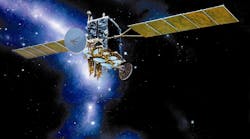UPDATE: AEHF Antenna Employs Electronically Steerable Beams
Update: Most recently, the satellite’s payload modules have been delivered by Northrop Grumman, nearly two months ahead of the AEHF schedule. Each module contains the processing, routing, and control hardware and software that perform the satellite’s communications functions. Delivery of the payload, as well as the recent delivery of the propulsion core, means that AEHF-4 is now ready to begin integration.
Previously: The next-generation protected military-communications satellite, Advanced Extremely High Frequency (AEHF), provides survivable, global, highly secure communications for strategic command and tactical warfighters. The satellites boast 10 times greater total capacity and channel data rates that are six times higher than those provided by legacy Milstar systems. Such features are made possible through high-speed-downlink phased-array antennas, which were recently integrated into the communications payload on the fourth AEHF satellite.
Northrop Grumman delivered the Super High Frequency Array Units (SAUs) to Lockheed Martin, the system’s prime contractor. The antennas provide assured point-to-point connectivity using electronically steerable beams as opposed to mechanical reflectors. At 20 and 40 GHz, respectively, the high-speed downlink and uplink phased-array antennas are the first of their kind to operate in space. The agility and flexibility of the beams offers wider coverage for tactical and strategic users globally.
The phased arrays use multiple beam types concurrently including the following: high-gain Earth coverage anywhere in the satellite field of view; super-high-gain Earth to 160 locations; and up to 24 medium-resolution-coverage-area (MRCA) spot beams. The MRCA antennas are designed to support dispersed user groups worldwide, such as naval carrier groups and submarines. The Super High Frequency Array Units were built by Northrop Grumman’s Antenna Products Center, which also provides jam-resistant nulling antenna subsystems, crosslink antennas, and steerable spot-beam antennas for the AEHF payload.
